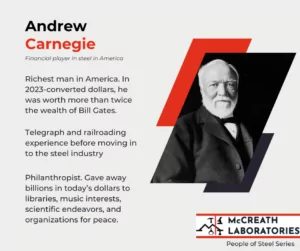Andrew Carnegie
Significant steel years 1864-1901
Financial player in steel in America
Dying with the title “richest American”, charismatic and socially popular Andrew Carnegie was born to a very poor Scottish family. His father was a weaver and political activist, who could get no work after a failed political movement. At various times in Andrew’s life, his mother was the family’s primary breadwinner. The family decided to follow his mother’s sister to the United States in 1848, arriving in New York City and making their way to the Allegheny area of western Pennsylvania. He began working at age 12 for a weaving mill as a bobbin boy but became a telegraph messenger boy who learned all the businesses and businessmen in the city. After learning this role, he moved on to the Pennsylvania Railroad (P.R.R.) where he met and cultivated friendships with Thomas A. Scott, the superintendent of the western division of the P.R.R., and John Edgar Thomson, president of the P.R.R. These two contacts and friendships would certainly contribute to Andrew Carnegie’s industrial success. When the Civil War began, Thomas Scott became the Assistant Secretary of War and put Andrew in a role leading the military’s railroad and telegraph, which perhaps solidified Carnegie’s desire to promote world peace in his later years.
Prior to the war, Carnegie invested in various industries related to railroading, but after the war, he became more focused on the steelworks. He began building his steel empire with the Keystone Bridge Company, which produced the rails bought by his P.R.R. connections. He bought the Homestead Steel Works built by Alexander Lyman Holley. He built a steelworks in Braddock, PA, and named it after his friend, former boss, and president of the Pennsylvania Railroad, J. Edgar Thomson. He built several more steelworks and blast furnaces and combined them all under the umbrella of the Carnegie Steel Company in 1892. Andrew and his railroad associates worked together to negotiate prices for steel and shipping via railroads instead of allowing free market pricing to rein. Carnegie also influenced Congress to continue trade tariffs on steel.
By 1901, Carnegie wanted to retire. The story goes that Carnegie sent J.P. Morgan a paper with the number he wanted to sell Carnegie Steel Company and Morgan immediately accepted. Morgan bought the Carnegie Steel Corporation and folded it into the newly forming United States Steel Corporation. Carnegie’s share of the sale amounted to $225.64 million, which is an estimated $7.9 billion in today’s dollars.
Andrew Carnegie was fairly liberal in his philosophical views. He was a proponent of women working. He was sympathetic to the policies of progressive taxation. He felt that the wealthy should be using their wealth for the enrichment of society. He, like his father, was an abolitionist and he bought several British newspapers that espoused that ideal. He was an anti-imperialist.
Carnegie had a philosophy that the first third of one’s life in the accumulation of education, the second third in the accumulation of wealth, and the final third in the distribution of that wealth to worthwhile, beneficial causes. He had his wife sign a prenuptial agreement acknowledging that Carnegie’s goal was to give away all the money before he died. He felt that philanthropy was key to making a life worthwhile. He felt it was shameful to die a rich man.
Carnegie had very little formal education. The education of his teenage years was self-driven and he benefited from the generosity of an Allegheny resident, Col. John Anderson, who opened his large personal library up each Saturday evening to the working boys of the town, so they could educate themselves. Carnegie resolved that “if wealth ever came to him” he would see to it that other poor boys might have the same opportunity. In total, Carnegie funded more than 2,500 libraries in 47 states and 8 countries.
Andrew Carnegie was also a patron of music. He was a founding backer of the National Conservancy of Music in America and built Carnegie Hall in New York City. He funded the construction of 7,000 pipe organs in churches and temples, without regard for religion.
Beyond those two focused areas of philanthropy, Carnegie gave money to hospitals, parks, laboratories, universities, and organizations working for peace. He was a large benefactor to the Tuskegee Institute. He funded pensions for former workers of the Homestead Works and another for American college professors.
In the end, Carnegie realized he would not be able to distribute all his wealth in his lifetime, so he established the Carnegie Corporation of New York, endowed it with $135 million (approximately $4.37 billion in today’s dollars) and dedicated to the principles of scientific philanthropy in the U.S. and the British Commonwealth.
See other People of Steel in our previous blog posts here.
Sources:
https://en.wikipedia.org/wiki/Andrew_Carnegie
https://www.carnegie.org/interactives/foundersstory/#!/
https://www.britannica.com/biography/Andrew-Carnegie
https://www.pbs.org/wgbh/americanexperience/features/carnegie-biography/
https://www.history.com/topics/19th-century/andrew-carnegie
